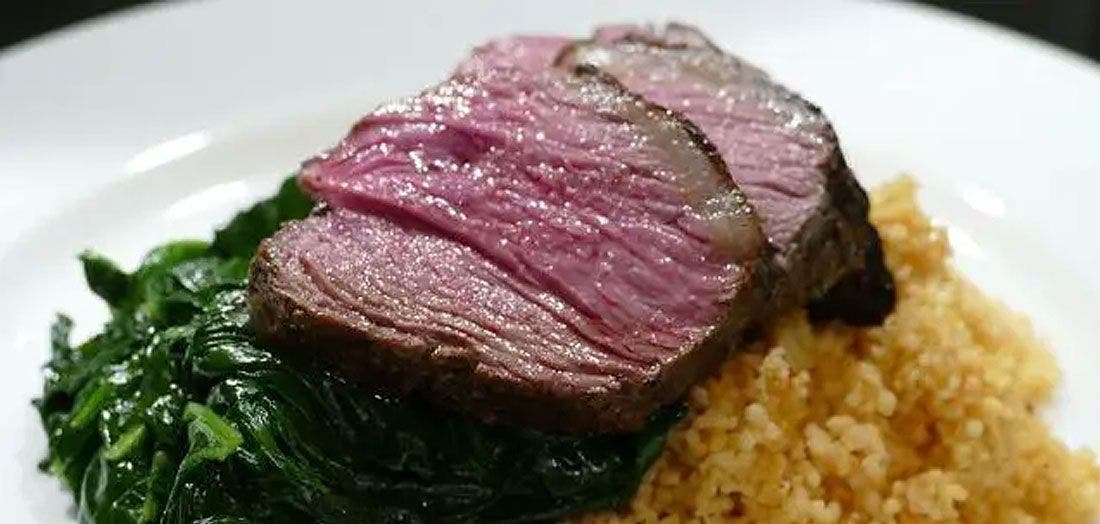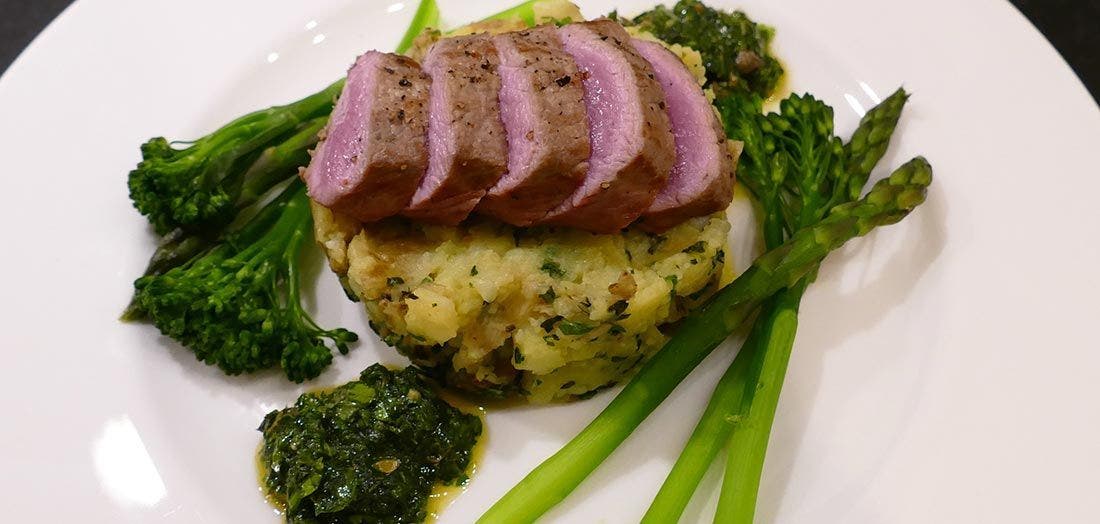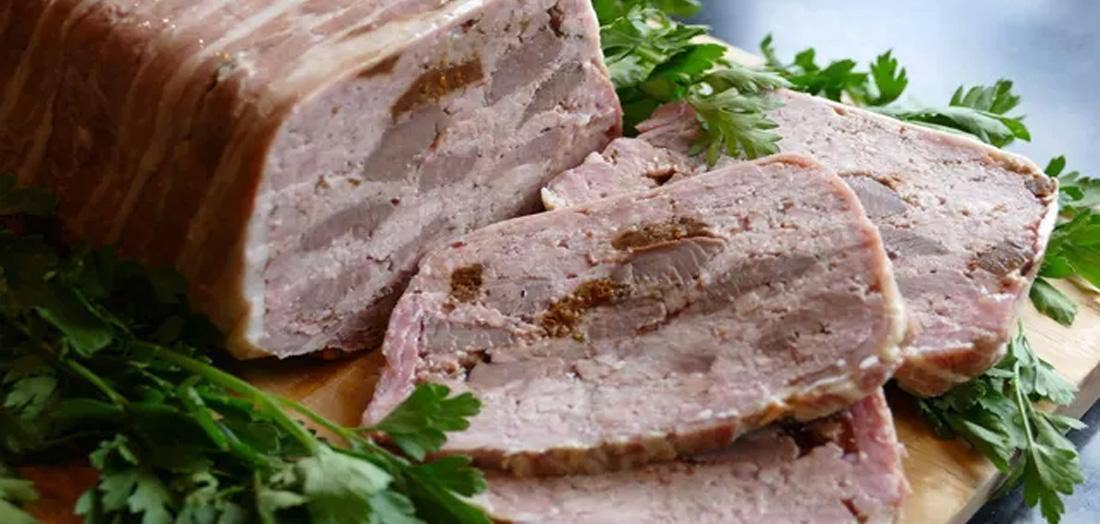At last, after so much rain, the sun has come out and it finally feels as though spring has arrived. It couldn’t come too soon for me. Not only does it mean a much easier, and drier, life looking after the horses and walking the dog but more excitingly heralds the arrival of so many thrilling ingredients in the kitchen. I’ve never been keen on buying Peruvian asparagus in September, much preferring to enjoy the glorious English varieties during their short season, eating as many as possible while they are at their prime and then happy to wait for the following year’s glut. Samphire will be here soon too, swiftly followed by all the other wonderful early summer vegetables; so much to look forward to.
But even though there’s less than a month to go now before we can enjoy those flavoursome spears they’re not quite here yet. If, like me, you try to buy as seasonally as possible, by this time of year it is easy to get a teeny bit weary of leafy greens. In our house we have had quite a lot of the various varieties of cabbage as well as curly kale, cavolo nero and, more recently, spring greens and purple sprouting broccoli. The latter is a very welcome addition to winter leaves, promising that something new and different will soon be arriving in our kitchens. In the meantime, however, it is possible to liven things up a bit by making a few simple additions.
 Annie Assheton is back in the Farlows kitchen, and looking forward to spring.
Annie Assheton is back in the Farlows kitchen, and looking forward to spring.Boiling or steaming is certainly quick and easy but cooking greens the same way every time is inevitably going to get dull and repetitive and I find it best to treat our winter staples as stars rather than understudies. Ring the changes by giving them some interesting roles and you might just find that they can, as Hugh Fearnley-Whittinstall wrote, “dazzle you with their previously unrecognised talents and leave you shouting for more.”
Try blanching anything leafy, then adding it to sizzling butter in which you have cooked some thinly sliced garlic and red chilli. Finely grated lemon zest would be good added to this too, as would be some chopped anchovies which go particularly well with lamb. They will melt away when cooked so will be safely unidentifiable to even the biggest detractor of these little bombs of salty flavour.
Another way to liven them up is to make your greens an integral part of your main dish, rather than just having them on the side. Cavolo nero, curly kale and spring greens are all brilliant at healthily bulking out a risotto whether it’s made with the traditional rice or perhaps with pearl barley or spelt, both wonderful alternatives. Just shred the leaves quite finely and add towards the end of the cooking time.
Recently I’ve been experimenting with a dish I normally cook with samphire, trying it out with greens available earlier in the year. Just toss some not too finely sliced potatoes (Maris Piper are ideal) in a bowl with some oil and seasoning before spreading them out on a shallow baking tray. After 12 minutes or so in the oven at 180°C some of them will be turning golden and crisp. At this point, weave through some blanched cavolo nero (or something similar) making sure that some of it is sheltering underneath the potato slices whilst some is sitting on top. Then it all goes back into the oven with some well-seasoned pieces of fish sitting on top until the latter is perfectly (and definitely not over) cooked. If I’m feeling indulgent I’ll put a knob of butter on each piece of fish. Some of the greens will be soft, having been protected by the potatoes, but the bits sticking out will have gone slightly crunchy giving them a whole new textural dimension as well as intense flavour.
This experiment was such a success it’s definitely no poor relation compared to the samphire graced original and is certainly going to become one of those vibrant dishes that brighten up the winter months in the future. This month, when watercress will be at its best, I’m going to add a bright green accompaniment by whizzing up plenty of peppery leaves with some mayonnaise and adding a squeeze of lemon juice and some salt.
Lamb is an obvious spring choice and it is so much more versatile than you might think. My feature recipe this time is something a bit different; a seldom used cut with the addition of slightly more exotic flavours than you might usually consider. The list of ingredients might look a bit fearsome but don’t let that put you off. You’ll find that most of them are in your kitchen already and it takes moments to whizz them into a marinade.
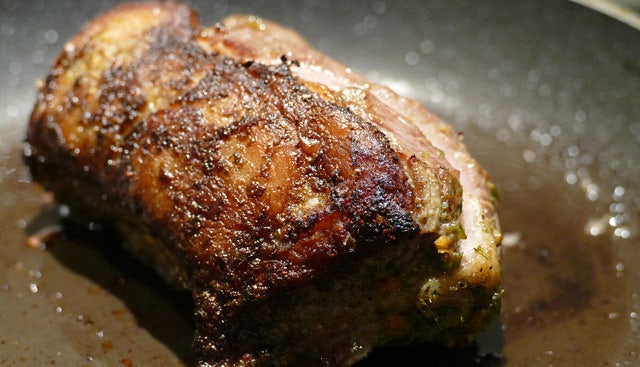 Lamb chump, sizzling in the pan...
Lamb chump, sizzling in the pan...The cut of lamb I’m using here is chump, most frequently sold as chops but so much more interesting, versatile and sumptuous as a whole piece. This isn’t something you can buy in the supermarket and most butchers won’t stock them in their displays but they should certainly be able to provide them on request. Just ask for a whole chump, off the bone, and you should be handed a cushion shaped piece of surprisingly lean meat, sitting beneath a lovely layer of fat under the skin. It’s from a hardworking part of the animal so the flavour is excellent and can take some punchy additions, but cooked right it will be lovely and tender.
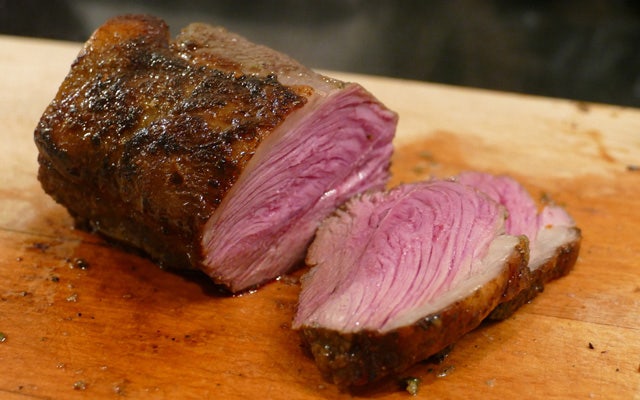 Carved, and perfectly cooked.
Carved, and perfectly cooked.If you want a roasting joint for two, this is the one for you. The layer of fat under the skin keeps everything juicy when cooked medium, it’s easy to carve and, being a less mainstream choice, extremely good value. This recipe shows it off to its best, in my opinion, marinating the chump in some vibrant flavours and pairing it with a spiced couscous very far removed from the bland stodge this grain can so easily be allowed to turn into.
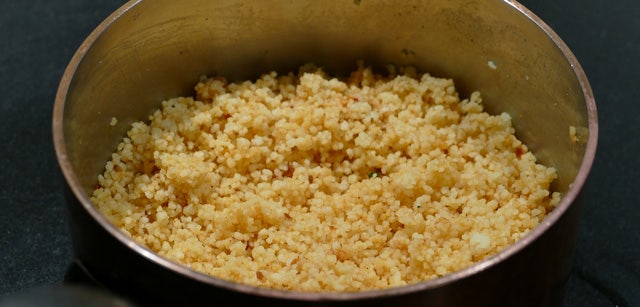 Harissa couscous
Harissa couscousIf you are after something a bit more traditional, a classic roast leg of lamb is of course a wonderful centrepiece for a weekend gathering of family and friends. The leg itself is something I wouldn’t presume to mess around with; pair with garlic and rosemary which can be either pushed into slits in the meat or pounded together with butter and perhaps an anchovy or two (just don’t tell anyone who thinks they don’t like them) and spread generously over the joint. I like to sit the joint on a trivet of widely sliced onion which both lifts it off the roasting tin to encourage even cooking and also adds to the flavour of the juices. You might also add some unpeeled garlic cloves and whole sprigs of rosemary too. With all this flavour the gravy will practically make itself; just spoon off the worst of the fat, deglaze with water, stock or something more festive and make sure you’ve scraped up all the gorgeous bits sticking to the pan.
With such a majestic joint of meat it would be a shame not to give it some worthwhile accompaniments that won’t overshadow but rather enhance its gorgeous flavour. Nothing can beat the usual and always welcome roast potatoes, but do think about jazzing up the green vegetables a bit. Try some of the ideas outlined above which will not only do justice to your lovely lamb but might also reawaken your interest in leafy greens.
Moroccan lamb with harissa couscous Serves 6
For the lamb 2 lamb chumps (approx 500g each) 1 tsp coriander seeds 1 tsp cumin seeds 1 pinch saffron 1 tsp black peppercorns 1 tsp juniper berries 1 orange, zest only 1 lemon, zest only 1 tbsp rosemary, leaves only 30g garlic 1 tbsp coriander stalks 125ml sunflower oil
For the couscous 240g couscous 1 tsp vegetable stock powder ½ tbsp rapeseed or sunflower oil 2 tsp harissa paste (a little goes a long way!)
Yoghurt dressing 200g natural yoghurt 1 tbsp each chopped mint and coriander 1 spring onion, finely sliced Squeeze lemon juice Salt and pepper
Start by making the marinade. Roast the coriander and cumin seeds in a frying pan, being careful not to let them burn. Put all of the marinade ingredients in a food processor and blend to a smooth paste, scraping the sides of the bowl as you go. Put 3 or 4 tablespoons of the marinade in a sealable freezer back with the lamb chumps and rub it all around so that the lamb is well coated. Marinate in the fridge for 24 hours is possible. (You can freeze the leftover marinade for next time)
To finish the lamb, scrape the excess marinade from the lamb sear the chumps on all sides in a hot pan with some sunflower oil (starting with the fatty side) until well coloured. Allow to cool before putting back into the fridge.
For the harissa couscous, put the couscous and stock powder into a small metal pan or bowl with a pinch of salt and cover with 375ml boiling water and the oil. Stir quickly and cover with a lid or clingfilm. Allow to stand for 10 minutes and then fork through to separate the grains and halt the cooking process. Stir through the harissa paste, taste and adjust seasoning then allow to cool.
For the yoghurt dressing, simply the yoghurt, mint, coriander and spring onion. Add lemon juice, salt and pepper to taste. Keep in the fridge until needed.
When you’re ready to serve, heat the oven to 200°C and cook the lamb chumps for 12 - 15 minutes depending on their size. Allow to rest for 10 minutes loosely covered with foil before carving.
You can serve the couscous cold but if you want to heat it through do so on the hob, stirring regularly to stop it from sticking. Serve the lamb in slices with the couscous, herbed yoghurt and a green salad.
 Annie Assheton's Moroccan lamb with harissa couscous
Annie Assheton's Moroccan lamb with harissa couscousThis is a fairly informal way of serving the lamb; perfect for a houseful or for a BBQ later in the year. If you want to use this recipe for a more glamorous occasion you can press the couscous into a chef’s ring and top it with spinach and then the sliced lamb. Serve with a lamb and red wine reduction.
Annie Assheton is looking forward to spring, and the arrival of so many thrilling new ingredients in the kitchen…
At last, after so much rain, the sun has started to come out and it finally feels as though spring is arriving. It couldn’t come too soon for me as it heralds the arrival of so many thrilling ingredients in the kitchen. I’ve never been keen on buying Peruvian asparagus in September, much preferring to enjoy the glorious English varieties during their short season, eating as many as possible while they are at their prime and then happy to wait for the following year’s glut. Samphire will be here soon too, swiftly followed by all the other wonderful early summer vegetables; so much to look forward to.
But even though there’s less than a month to go now before we can enjoy those flavoursome spears they’re not quite here yet. If, like me, you try to buy as seasonally as possible, by this time of year it is easy to get a teeny bit weary of leafy greens. In our house we have had quite a lot of the various varieties of cabbage as well as curly kale, cavolo nero and, more recently, spring greens and purple sprouting broccoli. The latter is a very welcome addition to winter leaves, promising that something new and different will soon be arriving in our kitchens. In the meantime, however, it is possible to liven things up a bit by making a few simple additions.
Boiling or steaming is certainly quick and easy but cooking greens the same way every time is inevitably going to get dull and repetitive and I find it best to treat our winter staples as stars rather than understudies. Ring the changes by giving them some interesting roles and you might just find that they can, as Hugh Fearnley-Whittinstall wrote, “dazzle you with their previously unrecognised talents and leave you shouting for more.”
Try blanching anything leafy, then adding it to sizzling butter in which you have cooked some thinly sliced garlic and red chilli. Finely grated lemon zest would be good added to this too, as would be some chopped anchovies which go particularly well with lamb. They will melt away when cooked so will be safely unidentifiable to even the biggest detractor of these little bombs of salty flavour.
Another way to liven them up is to make your greens an integral part of your main dish, rather than just having them on the side. Cavolo nero, curly kale and spring greens are all brilliant at healthily bulking out a risotto whether it’s made with the traditional rice or perhaps with pearl barley or spelt, both wonderful alternatives. Just shred the leaves quite finely and add towards the end of the cooking time.
Recently I’ve been experimenting with a dish I normally cook with samphire, trying it out with greens available earlier in the year. Just toss some not too finely sliced potatoes (Maris Piper are ideal) in a bowl with some oil and seasoning before spreading them out on a shallow baking tray. After 12 minutes or so in the oven at 180°C some of them will be turning golden and crisp. At this point, weave through some blanched cavolo nero (or something similar) making sure that some of it is sheltering underneath the potato slices whilst some is sitting on top. Then it all goes back into the oven with some well-seasoned pieces of fish sitting on top until the latter is perfectly (and definitely not over) cooked.
 Annie Assheton is back in the Farlows kitchen, and looking forward to spring.
Annie Assheton is back in the Farlows kitchen, and looking forward to spring.If I’m feeling indulgent I’ll put a knob of butter on each piece of fish. Some of the greens will be soft, having been protected by the potatoes, but the bits sticking out will have gone slightly crunchy giving them a whole new textural dimension as well as intense flavour.
This experiment was such a success it’s definitely no poor relation compared to the samphire graced original and is certainly going to become one of those vibrant dishes that brighten up the winter months in the future. This month, when watercress will be at its best, I’m going to add a bright green accompaniment by whizzing up plenty of peppery leaves with some mayonnaise and adding a squeeze of lemon juice and some salt.
Lamb is an obvious spring choice and it is so much more versatile than you might think. My feature recipe this time is something a bit different; a seldom used cut with the addition of slightly more exotic flavours than you might usually consider. The list of ingredients might look a bit fearsome but don’t let that put you off. You’ll find that most of them are in your kitchen already and it takes moments to whizz them into a marinade.
 Lamb chump, sizzling in the pan...
Lamb chump, sizzling in the pan... Carved, and perfectly cooked.
Carved, and perfectly cooked. Harissa couscous
Harissa couscousIf you are after something a bit more traditional, a classic roast leg of lamb is of course a wonderful centrepiece for a weekend gathering of family and friends. The leg itself is something I wouldn’t presume to mess around with; pair with garlic and rosemary which can be either pushed into slits in the meat or pounded together with butter and perhaps an anchovy or two (just don’t tell anyone who thinks they don’t like them) and spread generously over the joint. I like to sit the joint on a trivet of widely sliced onion which both lifts it off the roasting tin to encourage even cooking and also adds to the flavour of the juices. You might also add some unpeeled garlic cloves and whole sprigs of rosemary too. With all this flavour the gravy will practically make itself; just spoon off the worst of the fat, deglaze with water, stock or something more festive and make sure you’ve scraped up all the gorgeous bits sticking to the pan.
With such a majestic joint of meat it would be a shame not to give it some worthwhile accompaniments that won’t overshadow but rather enhance its gorgeous flavour. Nothing can beat the usual and always welcome roast potatoes, but do think about jazzing up the green vegetables a bit. Try some of the ideas outlined above which will not only do justice to your lovely lamb but might also reawaken your interest in leafy greens.
Moroccan lamb with harissa couscous recipe
Serves 6
For the lamb
2 lamb chumps (approx 500g each)
1 tsp coriander seeds
1 tsp cumin seeds
1 pinch saffron
1 tsp black peppercorns
1 tsp juniper berries
1 orange, zest only
1 lemon, zest only
1 tbsp rosemary, leaves only
30g garlic
1 tbsp coriander stalks
125ml sunflower oil
For the couscous
240g couscous
1 tsp vegetable stock powder
½ tbsp rapeseed or sunflower oil
2 tsp harissa paste (a little goes a long way!)
Yoghurt dressing
200g natural yoghurt
1 tbsp each chopped mint and coriander
1 spring onion, finely sliced
Squeeze lemon juice
Salt and pepper
- Start by making the marinade. Roast the coriander and cumin seeds in a frying pan, being careful not to let them burn. Put all of the marinade ingredients in a food processor and blend to a smooth paste, scraping the sides of the bowl as you go. Put 3 or 4 tablespoons of the marinade in a sealable freezer back with the lamb chumps and rub it all around so that the lamb is well coated. Marinate in the fridge for 24 hours is possible. (You can freeze the leftover marinade for next time)
- To finish the lamb, scrape the excess marinade from the lamb sear the chumps on all sides in a hot pan with some sunflower oil (starting with the fatty side) until well coloured. Allow to cool before putting back into the fridge.
- For the harissa couscous, put the couscous and stock powder into a small metal pan or bowl with a pinch of salt and cover with 375ml boiling water and the oil. Stir quickly and cover with a lid or clingfilm. Allow to stand for 10 minutes and then fork through to separate the grains and halt the cooking process. Stir through the harissa paste, taste and adjust seasoning then allow to cool.
- For the yoghurt dressing, simply the yoghurt, mint, coriander and spring onion. Add lemon juice, salt and pepper to taste. Keep in the fridge until needed.
- When you’re ready to serve, heat the oven to 200°C and cook the lamb chumps for 12 - 15 minutes depending on their size. Allow to rest for 10 minutes loosely covered with foil before carving.
- You can serve the couscous cold but if you want to heat it through do so on the hob, stirring regularly to stop it from sticking. Serve the lamb in slices with the couscous, herbed yoghurt and a green salad.
 Annie Assheton's Moroccan lamb with harissa couscous
Annie Assheton's Moroccan lamb with harissa couscousThis is a fairly informal way of serving the lamb; perfect for a houseful or for a BBQ later in the year. If you want to use this recipe for a more glamorous occasion you can press the couscous into a chef’s ring and top it with spinach and then the sliced lamb. Serve with a lamb and red wine reduction.


